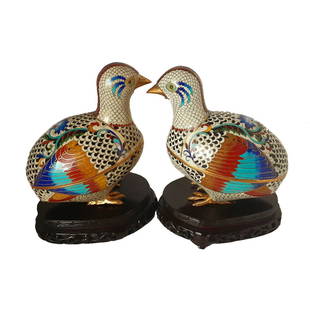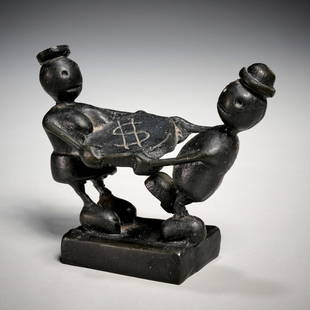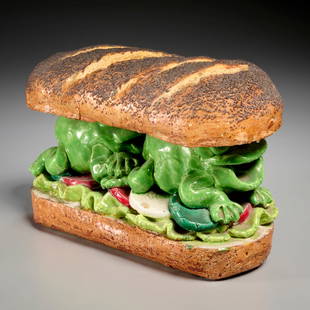
A RARE AND IMPORTANT BRONZE FIGURE OF AVALOKITESHVARA, ANKGOR PERIOD, BAYON STYLE
Similar Sale History
View More Items in Statues & Statuettes
Related Statues & Statuettes
More Items in Statues & Statuettes
View MoreRecommended Sculptures & Carvings
View More












Item Details
Description
Khmer, 12th-13th century. Superbly cast and powerfully modeled standing atop a tiered square base with his eight arms radiating and holding attributes with the wheel, book, elephant goad, and a jewel in his right hands and the conch, rosary, flask, and a dagger in his left. Dressed in a short sampot tied with a fanning fishtail and secured by an ornate belt with pendent tassels, adorned with beaded necklaces and plain double-anklets and armlets. His serene face with finely delineated features such as downcast eyes and full lips forming a benevolent smile. The neatly incised hair tied in braids and pulled up into a tall chignon centered by a diminutive image of the Buddha Amitabha.
Provenance: From the collection of Rene Ronveaux (d. 1991), Belgium, probably acquired in the Luxembourg or Belgian trade during the 1980s, and thence by descent to Robert Ronveaux (b. 1955). A copy of a provenance statement, written and signed by Robert Ronveaux, dated 11 September 2023, confirming the above, accompanies this lot.
Condition: Good condition, commensurate with age. Extensive wear, signs of weathering and erosion, casting flaws, nicks, scratches, and minuscule losses. The bronze with a rich, naturally grown patina with vibrant malachite encrustations.
Weight: 2.5 kg
Dimensions: Height 36.4 cm
The sacking of Angkor in 1177 resulted in innovative iconographical developments under Jayavarman VII towards a more potent theology incorporating Tantric and Esoteric Buddhist elements and cosmic symbolism devised to protect the empire. This form of a "Radiating Avalokiteshvara" represents one of the most complex iconographic forms. The karandavyuhasutra states that 'Avalokiteshvara, Lord of Infinite Compassion, bears the whole universe in his body. Every pore of his skin constitutes a world of its own filled with every kind of living being. His radiant spiritual power, symbolized by Amitabha, quickens in all these beings the Buddha nature that dwells within them.' The eight arms refer to the eight major directions, symbolizing cosmic totality. Also characteristic is the presence of an expressive smile, symbolic of Avalokiteshvara's compassion.
King Jayavarman VII (r. 1181-1218) constructed his own 'temple-mountain' at Bayon and developed the city of Angkor Thom around it. He also built Neak Pean ('coiled serpent'), one of the smallest but most beautiful temples in the Angkor complex, a fountain with four surrounding ponds set on an island in an artificial lake. The stele inscription of Preah Khan states that the King erected Buddha stone images, the Jayabuddhamahanatha, in twenty-three towns in different parts of his empire. Among those towns were Lavodayapura (modern Lopburi), Svarnapura, Sambukapattana, Srijayarajapuri (modern Ratchaburi), Srijayasimhapuri (modern Kanchanaburi), and Srijayavajrapuri (modern Phetburi). The present figure is a contemporary bronze variant of one of these twenty-three stone images.
This figure of Avalokiteshvara, the Boddhisatva of Compassion, is a bronze version of one of the twenty-three stone images of King Jayavarman VII sent to different parts of the Empire in 1191 in memory of his father.
Literature comparison:
Compare a closely related bronze figure of the eight-armed Avalokiteshvara, dated 12th-13th century, in The Walters Art Museum, accession number 54.2726. Compare a closely related bronze figure of the eight-armed Avalokiteshvara, dated ca. 1190-1210, in the Musee Guimet, object number MA 5940.
Auction result comparison:
Type: Closely related
Auction: Christie's New York, 17 September 1998, lot 179
Price: USD 134,500 or approx. EUR 234,000 converted and adjusted for inflation at the time of writing
Description: A large and important bronze figure of Avalokiteshvara, Khmer, Angkor period, Bayon style, late 12th century
Expert remark: Compare the closely related subject, modeling, and manner of casting, as well as the similar patina. Note the much larger size (59.2 cm).
Buyer's Premium
- 30%
A RARE AND IMPORTANT BRONZE FIGURE OF AVALOKITESHVARA, ANKGOR PERIOD, BAYON STYLE
Shipping & Pickup Options
Item located in Vienna, Vienna, atPayment













































































